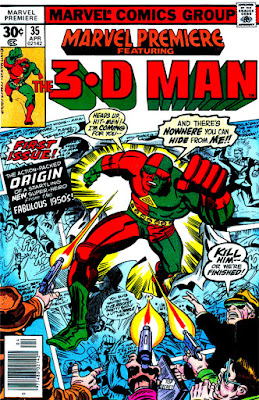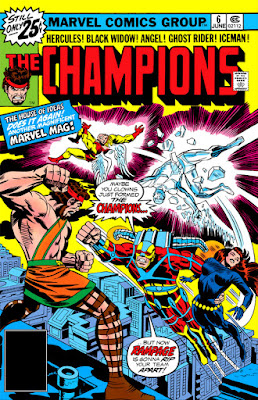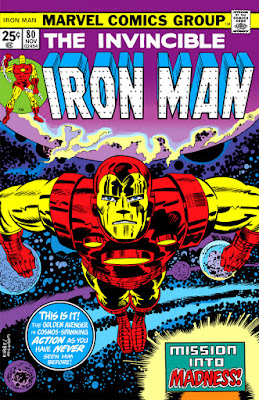Having seen a few of Jack Kirby's supplemental covers for Marvel books, drawn during his own "supplemental" stay at the company during the years 1976-77, let's round out that post by taking the opportunity to "cover" a little more ground and moving on to some of the other titles which received Mr. Kirby's attention under their mastheads.As was the case before, the books we'll see here might be surprising not only in terms of those titles that Kirby took an interest in, but also those that he opted not to contribute to (all of which is assuming these were Mr. Kirby's choices to make, rather than assignments from whoever was handling production matters). Frankly, with his workload as both writer and scripter of those books he produced on a monthly basis, the fact that Kirby managed to make room for the number of additional covers he turned in is something of a surprise in itself, to say nothing of not having lost his touch at making practically each of these cover images salesworthy as far as being able to stand out on the rack and entice the comics browser with the promise of adventure within. How regrettable that Marvel and Kirby were not able to work out a mutually beneficial way to coexist, though that's not to imply the dispute between them was one-sided. As we've seen in source material such as Marvel Comics The Untold Story, The Comics Journal, Wizard, and other forums that offered an outlet for frank opinion, the business side of the comics industry is at times an eye-opener for readers whose exposure to that industry is limited to the consumption of the wondrous, fantasy-based stories produced therefrom.
With each grouping of covers featured here, I'll again be including some comments and observations that came to mind (and of course looking forward to reading your own).
Let's begin with some of Kirby's lesser-known work in this area:
There's obviously a good deal of John Romita to be seen in the Spidey Super-Stories cover, though Romita was already doing quite a lot of cover work for the book; while those of you who recall Kirby's work on Mighty Thor no doubt recognize the inks of Vince Colletta on the Hercules issue of Marvel Premiere. I was always curious as to Kirby's thoughts on Colletta's work on his pencils; I must admit to going back and forth on Colletta's style, myself.
If the 3-D Man reminds you a little of Delroy Garrett, the Avenger known as Triathlon, that could be because of the "tri-power" (a term coined by the leader of the Triune Understanding, Jonathan Tremont) which empowered both characters.
Out of curiosity, can we have a show of hands from those of you who took an interest in Bill Mantlo's brainchild, Woodgod?
As we see, Kirby also included the 3-D Man in the What If tale featuring the 1950s Avengers. The later What If story certainly epitomizes the concept of "what if?" in regard to the general feeling that anything goes in the world of comics--in this case, members of the Marvel staff taking on the roles of the Fantastic Four (a tale which Kirby both drew and scripted).
The Invaders concept seemed tailor-made for contributions from Kirby, who at the time was producing the Captain America book as well as the character's bicentennial special. If Kirby's contract hadn't (presumably) specified that he would have creative control of the books he drew, I sometimes wonder if he might have put aside one of his other titles if offered the position of artist on The Invaders--admittedly a book whose focus on wartime battles, in addition to its interior art, never appealed to me.
It seemed either coincidence or personal preference that Kirby turned out a number of covers featuring the Liberty Legion, a group that made the rounds following their premiere in (appropriately enough) Marvel Premiere. A number of Legion members such as Red Raven, Jack Frost, the Blue Diamond, the Patriot, Miss America, and the Whizzer would also be featured in post-wartime stories.
Kirby's work on Marvel Two-In-One perhaps mostly serves to bring attention to the fact that none of his work would be found on the covers of the Marvel Team-Up title--a book headlined by Spider-Man, whose own title (along with Daredevil et al.) was skipped by Kirby. At the time, the cover art for MTU and MTIO was being handled by artists such as John Romita Jr., Dave Cockrum, Gil Kane, John Byrne, Rich Buckler, and Ron Wilson--no shortage of quality work there, and, again, there was only so much of Kirby to go around. :)
I'm afraid Kirby brought nothing new to the table for me with The Man Called Nova, another title that didn't rock my boat, nor was I tempted by what seemed a sales ploy in only its fourth issue that had the character gunning for Thor. I was also frankly dismayed by Kirby's antiquated view of how New York City police officers were outfitted in 1977; it didn't help matters that Nova never has a confrontation in the story with the police, two of whom merely catch a glimpse of him soaring toward a building.


Kirby's cover work for Invincible Iron Man was often the very definition of dynamic, fortunately for the stories within--particularly since, with perhaps the exception of the Ultimo battle, this period in the book's publication wasn't exactly anything to write home about. The fact that Kraken, a glorified pirate with an electric sword, can give Iron Man a hard time boggles the mind--Iron Man, a character who's dealt with enough depleted power scenarios to know that he wouldn't turn down an electric charge even if it were offered by Dr. Doom himself. And as for Iron Man's battles with the Melter, they rarely turned out to be his finest hours, something which even Kirby can't help but depict in this latest confrontation between the two.
As an aside, it took me a moment to pick out Kirby's work on issues 90 and 92, inked respectively by Jack Abel and Al Milgrom. Abel's finishes are often extensive to the point of overshadowing; and in this case, if it weren't for the young woman's facial features, the fact that this was pencilled by Kirby might have slipped right by me. In the case of #92, I find myself having to look closely to see Kirby's touch(es) in either the characters or the layout itself--a strange note on which to end such a retrospective.






























As a kid who collected all the Silver Age Kirby I could find, I really disliked Kirby's Marvel return...bad and not-at-all-nuanced writing, great ideas that really needed the hand of an editor, and that damn thick, heavy line drawing. Only Coletta inking that Hercules cover is any good.
ReplyDeleteWhile he stood apart from everyone with his incredible dynamics, the chock-a-block style of square fingers and wide exaggerated faces left me cold. Compare any Kirby cover to say, the George Perez art inside, and try to tell me the times hadn't completely passed him by.
It's a fair assessment of Kirby's shifted style in the late '70s, Factory, and there have certainly been many who are of the opinion that he might have met with more success with his work during that period if he would have consented to editorial oversight or ceded scripting to others. The "what might have been" aspect to Kirby's return to Marvel has been bandied back and forth in various forums for decades now, though it's good to know that there are others who nevertheless enjoyed what he brought to the books that he launched for both Marvel and DC in those years.
ReplyDeleteKirby on Nova 7 was a late substitution for Cockrum, after Cocktum's cover was rejected.
ReplyDeleteSome of Kirby's covers for the reprint comics Marvel Double Action and Marvel's Greatest Comics are interesting and may be worth posting.
Finally Kirby's relatively large quantity of Invaders/ Liberty Legion covers would have been due to the choice of the comic's editor, Roy Thomas, who obviously wanted a golden age artist for the covers. Roy also offered the FF to the Kirby, but sadly the King was no longer interested in collaborations.
Spirit of '64
Spirit, thanks for your comments. And you're in luck--you'll find a number of posts on Kirby's cover work for Marvel's Greatest Comics as well as one or two other reprint titles scattered throughout the PPC's cover to cover section.
ReplyDeleteThese Kirby Covers could really jump out of the spinner rack at a kid in those days. They did everything a cover was supposed to do; they grabbed your eyeballs. Like I've said, mass and energy colliding at high speeds.
ReplyDeleteI understand why Kirby didn't want to draw the Invaders, I don't blame him, but it sure could've been interesting.
He did a run earlier on the D.C. W.W. 2 comic the Losers, which he wrote and drew, and I thought it was great. And this from a guy who was there. Whos says that guy couldn't write a story? In one issue there was a page at the end depicting the various weapons each side used, illustrated and written by Kirby himself.
I'm not a war comic guy, but I enjoyed that run a lot.
I thought he did great covers for the F.F. during this period. Remember that one where the Thing is socking it out with the Destroyer on an asteroid?
Great post, C.F. seeing these covers brought back a lotta memories. A lot of 'em, I bought for the covers! I got sucked in.
M.P.
M.P., I imagine Kirby was in his element with The Losers. I have a coffee table book that features a good deal of his wartime-themed work as well as depictions of earlier years which I'll have to dig into sometime and make a few scans for posting.
ReplyDelete